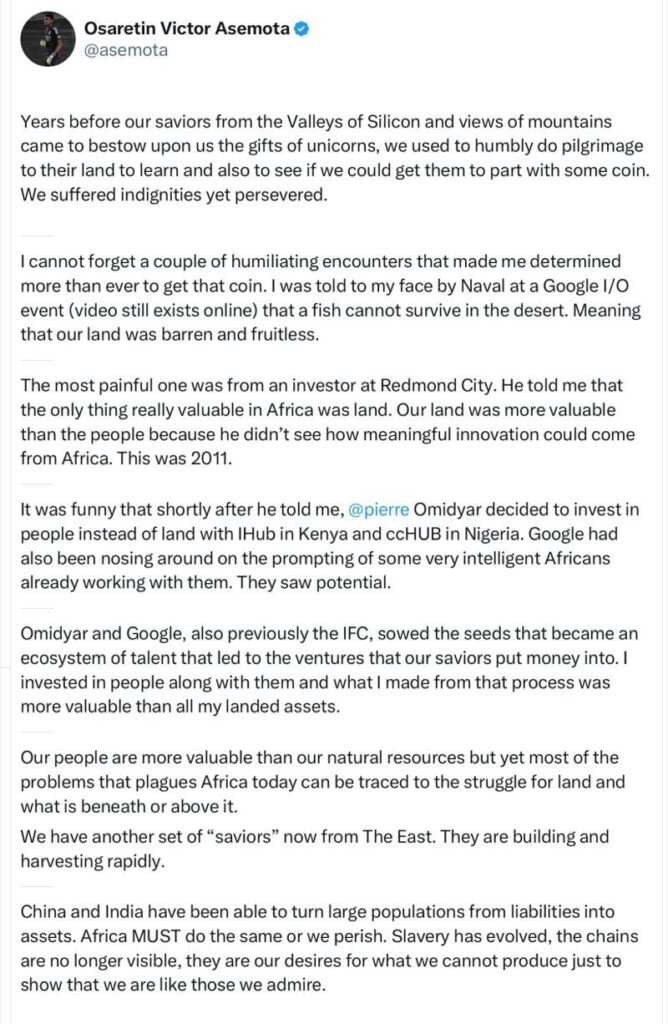In a recent LinkedIn post, Victor Asemota, Non-Executive Director at ARM Securities, shared his perspective on the journey of Africa’s tech ecosystem. His reflections offer a nuanced view of the challenges and triumphs that have shaped the continent’s technological landscape.
The Early Days: Silicon Valley Pilgrimages
Asemota recounts a time when African entrepreneurs regularly traveled to Silicon Valley, seeking both knowledge and investment. These journeys, while often difficult, were seen as necessary steps in bridging the gap between Africa and the global tech hub.
“We suffered indignities yet persevered,” Asemota writes, highlighting the determination that drove these early pioneers.
Memorable Encounters and Skepticism
Two particular interactions stood out in Asemota’s memory, illustrating the skepticism Africa’s tech potential faced:
- At a Google I/O event, Naval Ravikant reportedly told Asemota that “a fish cannot survive in the desert,” metaphorically suggesting that Africa’s environment was unsuitable for tech innovation.
- In 2011, an investor in Redmond expressed the view that land was Africa’s only valuable asset, doubting the continent’s capacity for meaningful innovation.
These encounters, while discouraging, served to fuel Asemota’s determination.

The Turning Point: Investing in People
Despite the skepticism, a shift began to occur. Asemota points to several key developments:
- Pierre Omidyar’s investment in tech hubs like iHub in Kenya and CcHUB in Nigeria.
- Google’s growing interest in African talent.
- Early involvement from the International Finance Corporation (IFC).
“Omidyar and Google, also previously the IFC, sowed the seeds that became an ecosystem of talent that led to the ventures that our saviors put money into,” Asemota explains.
The Value of Human Capital
A central theme in Asemota’s post is the importance of human capital. He argues that Africa’s people are its most valuable asset, surpassing even its abundant natural resources.
“Our people are more valuable than our natural resources,” he states, “but yet most of the problems that plague Africa today can be traced to the struggle for land and what is beneath or above it.”
Looking East: A New Dynamic
Asemota observes a new trend: the increasing involvement of Eastern countries, particularly China and India, in Africa’s tech landscape. He notes their rapid progress in building and harvesting opportunities on the continent.
This shift prompts Asemota to encourage a change in perspective: “We should look East and compete instead of looking West for validation.”
The Path Forward
Asemota concludes with a call to action for Africa:
- Emulate China and India in transforming large populations from “liabilities into assets.”
- Focus on developing and leveraging human potential rather than solely relying on natural resources.
- Be cautious of new forms of economic dependency, warning that “Slavery has evolved, the chains are no longer visible, they are our desires for what we cannot produce just to show that we are like those we admire.
Victor Asemota’s reflections provide a valuable insider’s perspective on the evolution of Africa’s tech ecosystem. From early struggles and skepticism to the current landscape of growing opportunity and new challenges, his post serves as both a historical account and a roadmap for the future. It underscores the importance of believing in and investing in African talent, while also remaining vigilant about the continent’s place in the global tech economy.
As Africa continues to carve out its space in the tech world, Asemota’s words remind us of the journey taken and the path that lies ahead.
